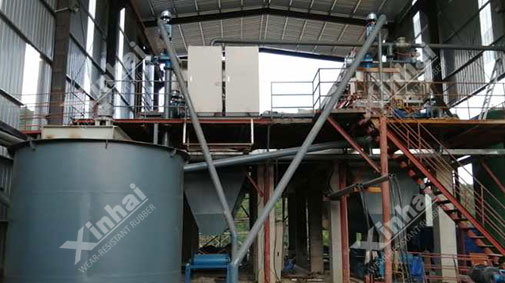In recent years, tailings dry stacking technology has developed rapidly. Tailings dry stacking technology is to process tailings slurry through multi-stage concentration and efficient dewatering equipment to form slag with low water content, easy transportation and stacking. Its core is dewatering technology. What are the common processes and main equipment for dry stacking of iron concentrate tailings? What are the existing problems and development prospects? This article will provide the answer.
The significance of tailings dry stacking lies in its ability to control and reduce safety hazards, save resources, lower operating and management costs, and reduce pollution. It is of great importance for the safe operation, resource utilization, and environmental protection of enterprises. In 1973, Canada first adopted tailings dry stacking technology, and more and more mines around the world began to adopt it.

1. Only filtration dehydration is used
The equipment used includes a filter or press filter. After the tailings slurry passes through the filter or pressure filter, the filtrate is directly used as return water, and the filter cake is transported to the dry storage yard for storage. This process has simple configuration and mature technology, and has been widely used in the mining industry, such as the Guijiazhuang gold mine in Shandong, the Da'anhe gold mine, the Zhenyuan gold mine in Yunnan, the Paishanlou gold mine in Lianning, the Tianshuizi gold mine in Gansu, and the Hami gold mine.
2. Concentration filtration dehydration process
The equipment used mainly includes thickeners, filters, or filter presses. The tailings slurry is concentrated by a thickener, and the overflow is directly returned to water for reuse. The bottom flow is filtered by a filter or pressure filter, which can reduce the moisture content of the tailings to less than 10%. This dehydration process has a relatively simple configuration, mature technology, good safety, and wide application. In recent years, filter presses have evolved from semi automated to fully automated, becoming a relatively sophisticated filtration equipment that has improved production efficiency to a certain extent and brought greater benefits to enterprises.
3. Classification concentration filtration dehydration process
The equipment used mainly includes cyclones, thickeners, filters or pressure filters. Some enterprises have uneven distribution of tailings particles and excessive fine particles during concentration, which can cause turbid overflow water from the thickener and low bottom flow concentration. In this case, if a cyclone is used for classification before concentration to separate coarse and fine tailings particles, it can achieve rapid concentration and improve the concentration effect of the thickener. Compared with the concentration filtration dehydration process, this process only adds a cyclone, but can greatly improve the processing capacity of the thickener, reduce the load on the thickener, and obtain tailings slag with a moisture content of less than 15%, with considerable economic benefits.
In addition, a new dehydration process has emerged by adding high-frequency dehydration screens on the basis of the third process. The tailings are classified by a cyclone, and the coarse particles in the bottom flow reach the high-frequency dewatering screen. After further dewatering by the high-frequency dewatering screen, the moisture content is reduced to less than 16%; The low concentration overflow liquid passing through the cyclone is then dehydrated by the thickener and filter press. This process is suitable for all mineral species with a particle size content of -0.037mm and a high dehydration rate, but the process is relatively complex, with large equipment investment and high production and operation costs.
The classification equipment mainly includes cyclones, inclined plate classifiers, spiral classifiers, etc. The new high-efficiency cyclones adopt multiple new technologies; The concentration equipment mainly includes ordinary circular thickeners, inclined tube thickeners, inclined plate thickeners, and high-efficiency thickeners. The high-efficiency deep cone multi cone thickener has better concentration effect; Dehydration equipment mainly includes filter machines, filter presses, and dehydration screens, among which high-efficiency multi frequency dehydration screens are widely used.
Existing problems: In terms of technology, the tailings dry stacking process is relatively complex and the dehydration cost is high, with limitations in application. There is a lack of research on tailings dry stacking technology in rainy areas, and no design specifications and standards have been formulated. After tailings dry stacking, slag is prone to dust pollution; In terms of management, it is necessary to formulate a set of safety management regulations for tailings dry stacking.
Development prospects: lower cost, better economic benefits, wider application, and safer application.
Tailings dry stacking technology has developed rapidly in recent years and has been successfully applied in many beneficiation plants. With the continuous in-depth research on iron concentrate powder tailings dry stacking technology, various equipment combination modes have achieved good results, and tailings dry stacking technology has become increasingly mature. Xinhai has rich experience in tailings dry stacking. If you have tailings that need to be treated, please contact us.